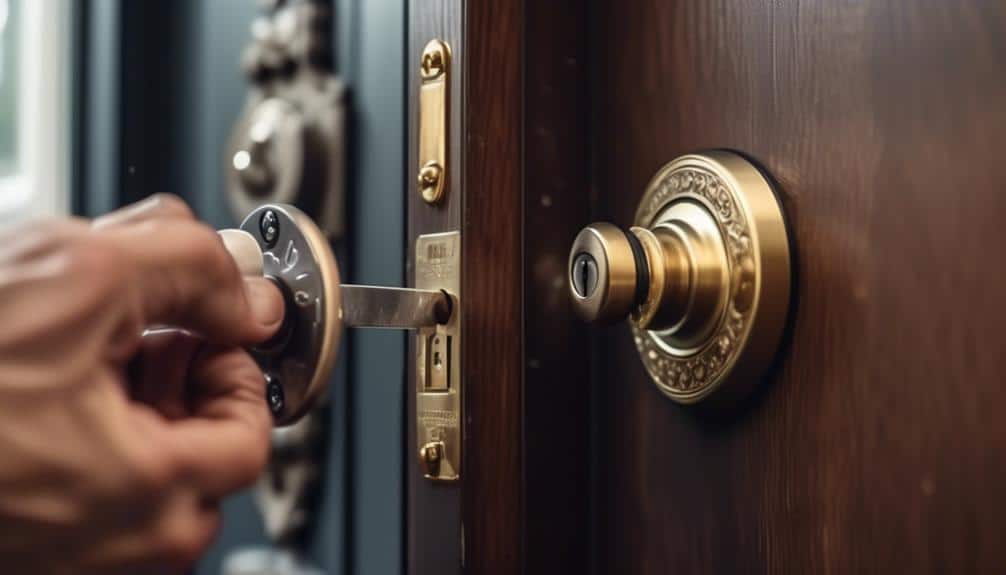Are you moving into a new home and want to ensure the safety and security of your family? Installing locks in your new home is an essential step towards achieving that goal. But where do you start? With so many options and considerations, it can be overwhelming.
Fear not, as we have compiled a list of essential tips to guide you through the process. From choosing the right type of locks to maintaining and updating them regularly, we've got you covered.
So, let's dive in and discover how you can fortify your new home and enjoy peace of mind.
Determine the Right Type of Locks

When it comes to installing locks in new homes, it's crucial to carefully determine the right type of locks for optimal security and peace of mind. Choosing lock brands and understanding lock grading are essential factors to consider.
When selecting lock brands, it's important to go for reputable manufacturers known for their quality and reliability. Brands such as Schlage, Kwikset, and Yale have established themselves as leaders in the industry, offering a wide range of locks to suit different needs and preferences.
Understanding lock grading is another crucial aspect of selecting the right type of locks for your new home. Locks are graded based on their durability and security features. The American National Standards Institute (ANSI) provides a grading system that categorizes locks into three levels: Grade 1, Grade 2, and Grade 3.
Grade 1 locks offer the highest level of security and are typically recommended for commercial properties or high-security residential areas. Grade 2 locks are suitable for most residential properties, providing a good balance between security and cost. Grade 3 locks, on the other hand, are more basic and are commonly used for interior doors or low-security applications.
Consider the Security Level Needed
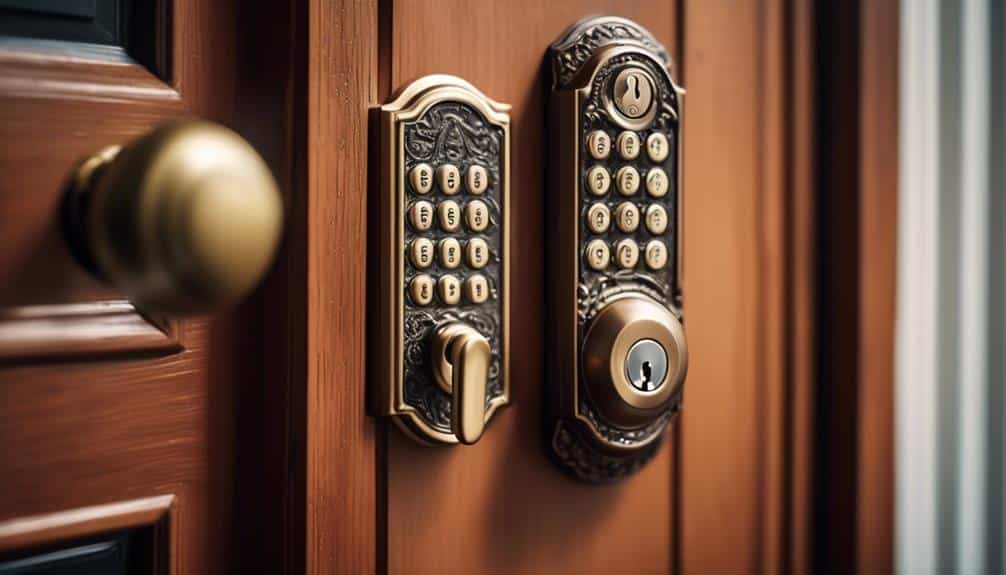
To ensure the highest level of security for your new home, it's essential to carefully consider the required security level. Taking into account the prevalence of home invasions and the importance of protecting your loved ones and valuables, it's crucial to invest in a robust security system.
Here are three key factors to consider when determining the security level needed:
- Location: Assess the crime rate and security risks in your neighborhood. Is it a high-crime area? Are there frequent reports of break-ins? Understanding the security challenges specific to your location will help you gauge the level of protection needed.
- Lifestyle: Consider your daily routines and lifestyle habits. Do you travel often? Are you frequently away from home for long periods? If so, you may require enhanced security measures such as surveillance cameras, motion sensors, and remote access control to monitor your property even when you're not there.
- Valuables: Evaluate the value and significance of the possessions you keep in your home. If you have expensive jewelry, artwork, or other valuable items, it may be necessary to invest in additional security measures like safes or enhanced door locks to safeguard these valuable assets.
Measure and Mark the Door for Installation
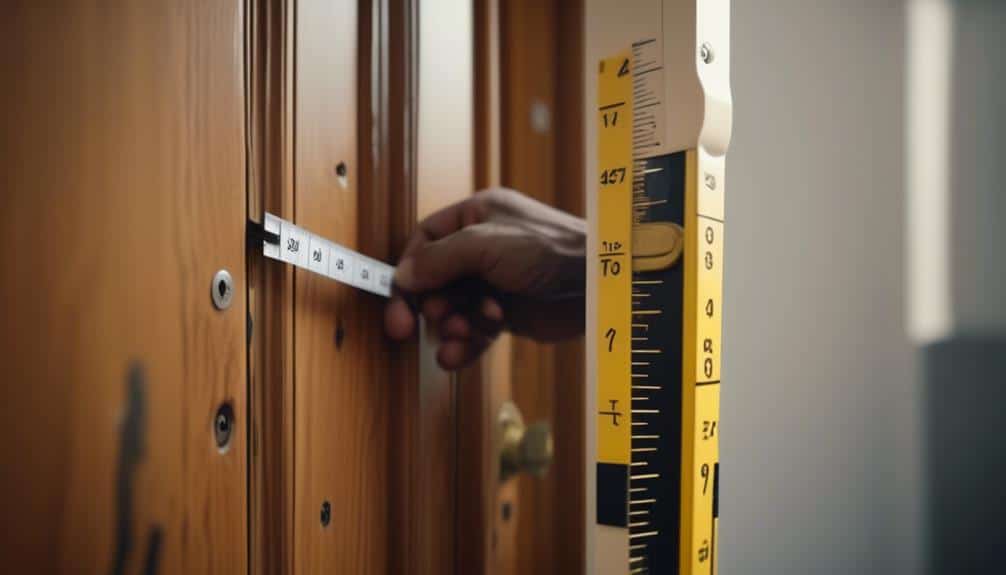
Now, let's dive into the process of measuring and marking the door for lock installation. This step is crucial to ensure that the door hardware and lock are properly aligned and fit securely.
When it comes to door lock options, there are various types available, including deadbolts, knob locks, and electronic locks. Each type requires different measurements and markings, so it's essential to choose the right one for your needs.
To begin, gather the necessary tools such as a tape measure, pencil, and masking tape. Measure the door's width and height accurately, taking into account any irregularities or obstructions. Next, determine the backset, which is the distance from the edge of the door to the center of the lockset. This measurement is essential when installing a deadbolt or knob lock.
Once you have the measurements, mark the door using a pencil and masking tape. Ensure that the marking is clear and visible. Use a level to make sure the markings are straight and aligned properly.
When marking the door, consider the height and placement of the lock. It should be at a comfortable height for easy access but also high enough to deter potential intruders. Additionally, check the manufacturer's instructions for any specific requirements or recommendations.
Prepare the Door for Lock Installation
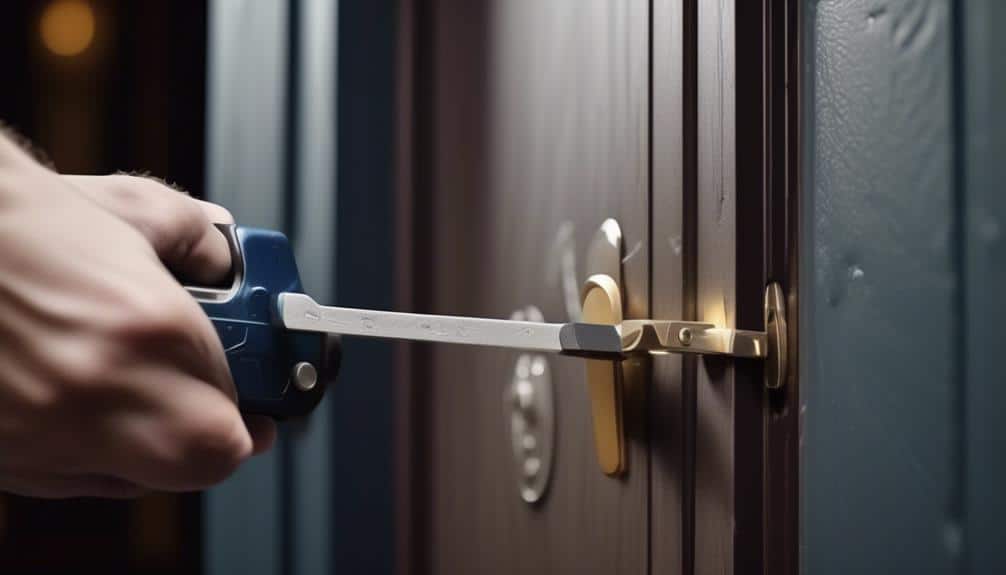
Now that we've measured and marked the door for lock installation, it's time to prepare the door itself. This step is crucial to ensure a smooth and secure installation.
We'll need to carefully examine the door and make any necessary adjustments, such as trimming or reinforcing the frame, to ensure that the lock fits properly. Additionally, we must select the right lock for the door based on its material and security needs.
Properly preparing the door will lay the foundation for a successful lock installation.
Door Measurement and Preparation
Proper door measurement and preparation is essential for a successful lock installation, ensuring a secure and seamless fit. When it comes to installing locks in new homes, we understand the importance of precise measurements and thorough preparation. Here are three key steps to consider:
- Measurements: Accurate measurements are crucial in selecting the right door hardware and lock brands. Measure the door thickness, height, and width to ensure compatibility with the chosen lock.
- Preparation: Before installing the lock, make sure the door is properly aligned and any existing hardware is removed. Smooth out any rough edges or uneven surfaces to ensure a clean and flush installation.
- Drilling: Use the correct drill bit size and depth to create clean and precise holes for the lockset and deadbolt. Take care to align the holes properly to avoid any misalignment issues.
Choosing the Right Lock
To ensure a secure and seamless fit, selecting the right lock for your door is a crucial step in preparing for lock installation in new homes.
When choosing the right lock, it's important to compare lock brands to find the one that best suits your needs. Start by considering the level of security you require. Some locks offer basic security features, while others provide advanced functionalities like keyless entry or smart home integration.
Additionally, consider the durability of the lock and its resistance to forced entry. Look for reputable lock brands that have a proven track record of quality and reliability. Take the time to read reviews and gather information about different lock options before making a decision.
Proper Installation Techniques
When it comes to ensuring the security of your new home, one of the most important steps is properly preparing the door for lock installation. This involves using the right installation tools and avoiding common installation mistakes.
Here are three essential tips to help you with the process:
- Measure accurately: Before starting the installation, make sure to measure the door and the lock correctly. This will ensure a proper fit and prevent any issues later on.
- Use the right tools: Having the appropriate installation tools, such as a drill, chisels, and a screwdriver, is crucial for a successful installation. Using the wrong tools can lead to damage or improper functioning of the lock.
- Avoid common mistakes: Some common installation mistakes include misaligning the strike plate, using screws that are too short, or not properly securing the lock cylinder. Being aware of these mistakes and taking the necessary precautions will help you avoid any potential security risks.
Install the Deadbolt Lock
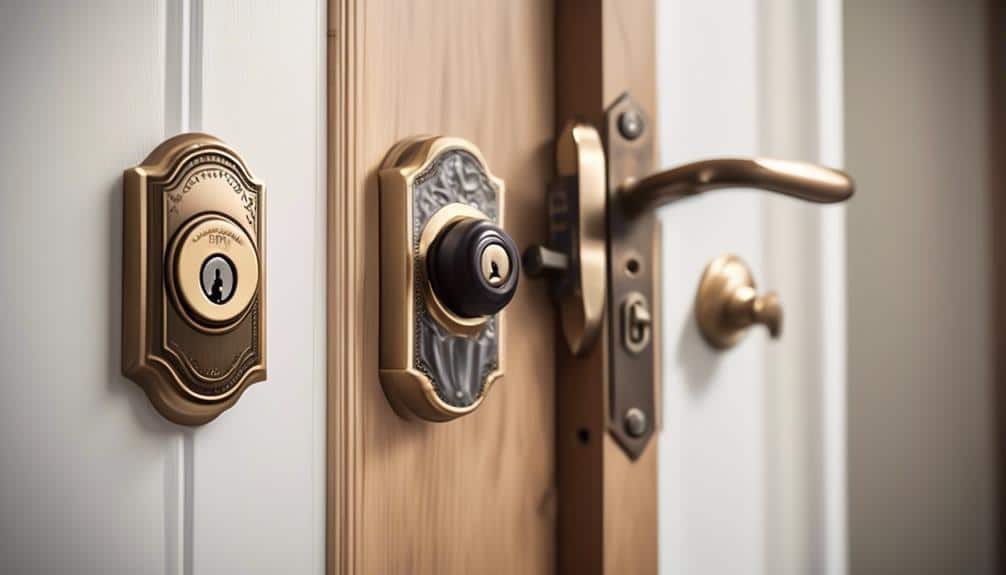
When it comes to installing deadbolt locks in new homes, there are several points to consider.
First, understanding the different lock types and features available is crucial in order to select the best option for your home security needs.
Additionally, proper deadbolt installation is essential to ensure that the lock functions effectively and provides the maximum level of protection.
Lastly, by installing a deadbolt lock, you're enhancing the overall security of your home, giving you peace of mind and deterring potential intruders.
Lock Types and Features
We highly recommend installing a deadbolt lock as part of your home security system. Deadbolt locks provide an added layer of protection for your home, making it more difficult for potential intruders to gain entry.
Here are three reasons why you should consider installing a deadbolt lock:
- Enhanced Security: Deadbolt locks are more secure than traditional locks because they require a specific key or code to unlock. This makes it harder for burglars to pick or force the lock open.
- Durability: Deadbolt locks are made of sturdy materials such as solid steel or brass, making them resistant to tampering or damage. They're designed to withstand a significant amount of force, providing long-lasting security for your home.
- Keyless Entry Option: Many deadbolt locks now come with keyless entry features, allowing you to unlock your door using a keypad or smartphone app. This eliminates the need for physical keys, reducing the risk of lost or stolen keys.
Proper Deadbolt Installation
To properly install a deadbolt lock, begin by ensuring that you have all the necessary tools and materials. Common deadbolt mistakes can be easily avoided by following the correct installation steps.
First, mark the centerline on the door and drill a hole for the deadbolt cylinder. Make sure the hole is deep enough to accommodate the entire cylinder.
Next, mark the outline of the strike plate on the door jamb and chisel out the recess for it. Secure the strike plate with screws.
Finally, install the deadbolt latch and cylinder into the door and secure them with screws.
It's important to note the importance of professional installation when it comes to deadbolt locks. A professional locksmith has the expertise and experience to ensure that the deadbolt is installed correctly, providing optimal security for your home.
Enhancing Home Security
Now let's move on to enhancing the security of your home by installing the deadbolt lock, ensuring maximum protection for your property and loved ones.
- Smart home technology: By integrating your deadbolt lock with smart home technology, you can remotely monitor and control access to your home. This allows you to grant temporary access to trusted individuals, receive real-time notifications of any unauthorized attempts, and even lock or unlock your door from anywhere.
- Neighborhood watch programs: Joining a neighborhood watch program can significantly enhance the security of your home. These programs encourage residents to look out for each other, report suspicious activities, and share information about potential security threats. By actively participating in a neighborhood watch program, you create a strong sense of community and deter criminals from targeting your area.
- Additional security measures: In addition to installing a deadbolt lock, consider implementing other security measures such as security cameras, motion sensor lights, and alarm systems. These additional layers of security can provide further protection and peace of mind for your home and family.
Install the Doorknob Lock
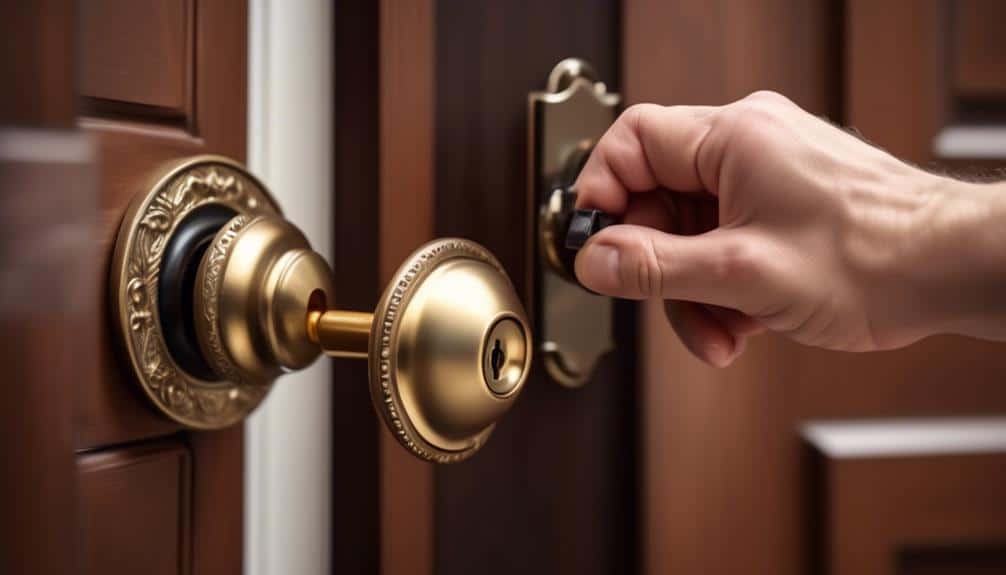
For the installation of the doorknob lock, consider using a screwdriver to remove the existing doorknob. This step is crucial to ensure a smooth and hassle-free installation process. Before beginning, make sure you have the necessary tools on hand, including a new doorknob lock, a screwdriver, and screws.
To start, locate the screws on the interior side of the existing doorknob. Using a screwdriver, carefully unscrew these screws and set them aside. Once the screws are removed, gently pull the doorknob away from the door, releasing it from the door latch.
Next, take your new doorknob lock and align it with the holes on the door. Ensure that the latch mechanism lines up with the existing door strike plate. Once aligned, insert the screws into the holes and tighten them using a screwdriver. Be careful not to overtighten, as this could strip the screw holes.
Finally, test the doorknob lock by turning the knob and ensuring that the latch smoothly engages with the strike plate. If everything is working properly, you have successfully installed your doorknob lock. Remember to keep the screws tight but not overly tight, as this can affect the functionality of the lock.
Installing a doorknob lock may seem daunting at first, but with the right tools and careful attention to detail, it can be a straightforward process. By following these steps, you can enhance the security of your home and provide peace of mind for you and your family.
Test the Locks for Proper Functioning
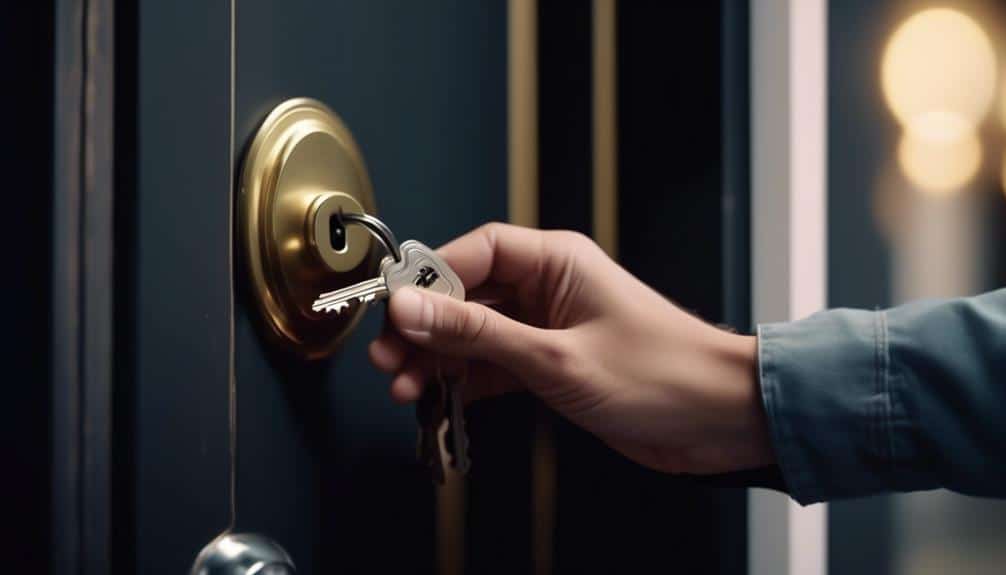
After successfully installing the doorknob lock, it's important to test its proper functioning to ensure the security of your new home. Testing the locks and checking their functionality is a crucial step that shouldn't be overlooked. Here are three reasons why testing the locks is essential:
- Peace of mind: Testing the locks provides reassurance that they're working correctly and will effectively secure your home. Knowing that your locks are functioning properly can give you peace of mind, allowing you to feel safe and protected in your new space.
- Preventing potential break-ins: By testing the locks, you can identify any issues or weaknesses in their functionality. Fixing these problems early on can prevent potential break-ins or unauthorized access to your home, ensuring the safety of your family and belongings.
- Avoiding lockouts: Testing the locks also helps you familiarize yourself with their operation. This can prevent frustrating lockouts in the future, saving you time and hassle.
To test the locks, try inserting and turning the key smoothly, ensuring that it locks and unlocks easily. Check if the latch aligns properly with the strike plate and that the door closes securely. Additionally, test any additional features such as deadbolts or electronic keypads to ensure they're functioning as intended.
Taking the time to test your locks will provide you with the confidence and security you need in your new home.
Secure the Strike Plate
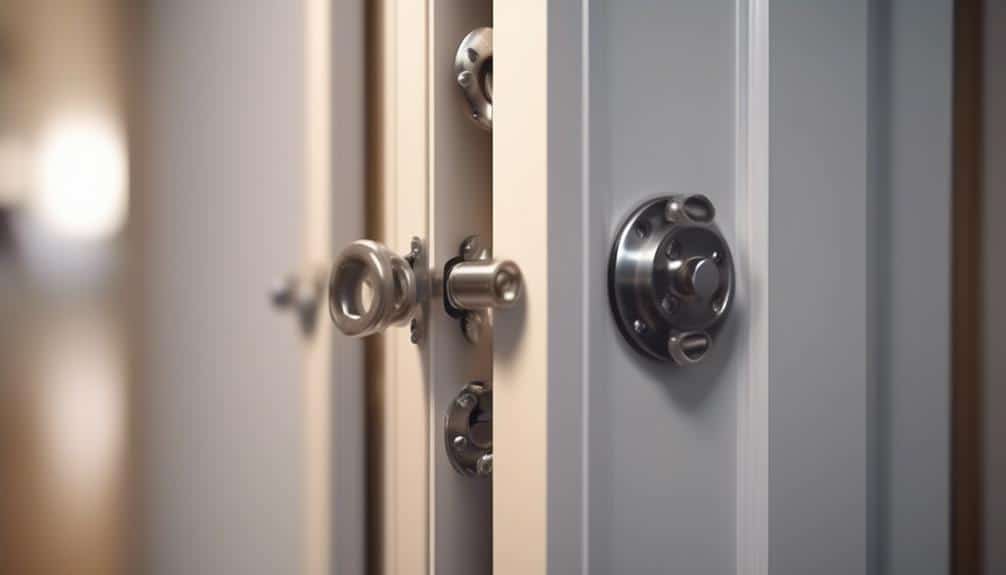
To ensure the proper installation and functioning of the lock, it's crucial to securely attach the strike plate to the door frame. The strike plate is an essential component of a lock system as it provides the necessary reinforcement to prevent forced entry. When installing the strike plate, it's important to choose a high-quality plate that's durable and resistant to tampering.
To begin the strike plate installation process, first, align the plate with the latch bolt on the door jamb. Make sure it's centered and level to ensure proper engagement with the door lock. Next, mark the screw holes on the door frame using a pencil or marker. Pre-drill these holes to prevent the wood from splitting during installation.
Once the holes are prepared, securely attach the strike plate to the door frame using screws that are long enough to penetrate the frame and provide a strong anchor. Use a screwdriver or drill to tighten the screws, ensuring a snug fit.
To enhance strike plate security, consider using longer screws that reach the door frame's studs for maximum strength. This will make it more difficult for potential intruders to kick in the door or force it open. Additionally, reinforcing the strike plate with a metal strike plate cover can provide an extra layer of protection.
Maintain and Update Locks Regularly
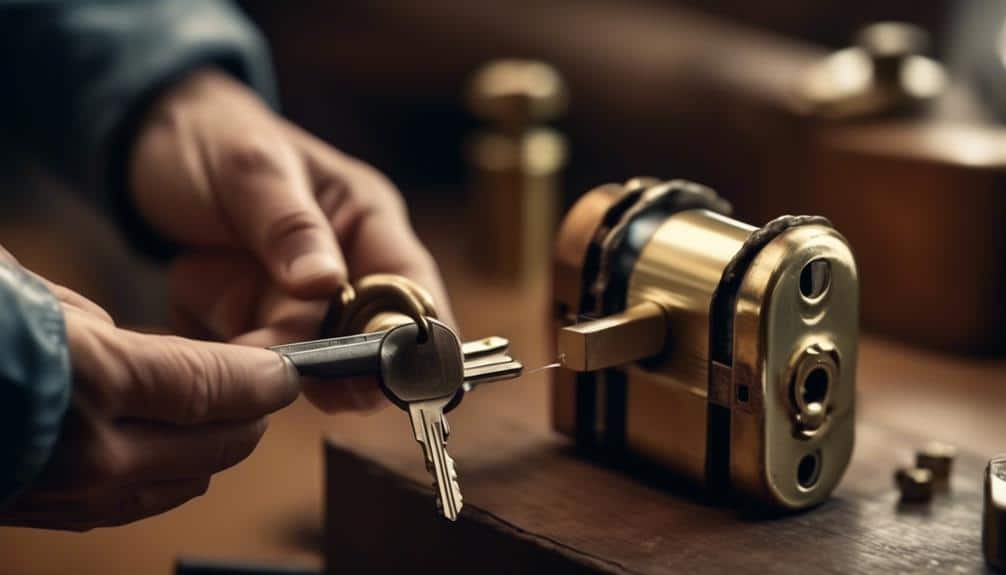
Regular maintenance and updating of locks is essential to ensure their optimal functionality and to enhance the security of your home. Neglecting lock maintenance can lead to issues such as jammed locks, broken keys, and compromised security. By following a few simple steps, you can keep your locks in top condition and ensure the safety of your home and loved ones.
Here are three crucial reasons why lock maintenance and updates should be a priority:
- Preventive Measures: Regularly maintaining your locks can prevent potential problems before they occur. By lubricating the lock mechanism, cleaning dust and debris, and checking for loose screws, you can minimize the risk of lock malfunctions. This proactive approach can save you from the inconvenience and stress of dealing with a lockout situation.
- Enhanced Security: Lock technology constantly evolves to counter new threats. By updating your locks, you can take advantage of the latest advancements in security features. Whether it's upgrading to a smart lock system or installing a deadbolt with reinforced strike plates, staying up-to-date with lock updates ensures your home remains secure against modern burglary techniques.
- Peace of Mind: Knowing that your locks are well-maintained and up-to-date provides peace of mind. It allows you to confidently leave your home, knowing that you've taken the necessary steps to protect it. Having secure locks not only deters potential intruders but also provides a sense of comfort and safety for you and your family.
Frequently Asked Questions
How Do I Choose Between a Deadbolt Lock and a Doorknob Lock?
When deciding between a deadbolt lock and a doorknob lock, it's important to consider the key differences.
Deadbolt locks offer superior security, as they have a longer bolt that extends into the door frame. They are harder to pick or force open compared to doorknob locks.
On the other hand, doorknob locks are more convenient for everyday use and can be easily unlocked without a key.
Ultimately, the choice depends on your specific needs and priorities.
Can I Install a Smart Lock on My New Home?
Yes, you can definitely install a smart lock on your new home.
Smart locks are compatible with most modern doors and offer numerous benefits.
With a smart lock, you can easily control and monitor access to your home through your smartphone.
You can grant temporary access to guests, receive notifications when someone enters or leaves, and even lock or unlock your door remotely.
Smart locks provide added convenience and security, making them a great choice for your new home.
What Is the Recommended Height for Installing Locks on a Door?
When it comes to installing locks on a door, one important aspect to consider is the recommended height. Installing locks at the right height is crucial for ensuring maximum security and convenience.
It's recommended to install locks at a height that's comfortable for most individuals, typically around 36 to 48 inches from the floor. This higher placement offers several advantages, such as making it more difficult for intruders to reach or tamper with the lock, enhancing the overall security of your home.
Are There Any Specific Tools Required for Installing Locks?
There are specific tools for lock installation that are essential for a proper and secure installation. One of the most important tools is a drill, which is used to create holes for the lockset.
Additionally, a chisel is needed to carve out the recesses for the strike plate. It's crucial to measure the door accurately before starting the installation to ensure the lock fits correctly.
Taking precise measurements will help avoid any future issues with the lock's functionality or security.
How Often Should I Update My Locks for Optimal Security?
When it comes to updating locks for optimal security, we've got you covered. Let's weigh the pros and cons of rekeying locks vs. replacing locks.
Rekeying is a cost-effective option that changes the key while keeping the existing lock.
On the other hand, replacing locks provides a fresh start with new hardware.
Common signs that indicate it's time to update your locks include worn-out keys, loose or sticky locks, and recent break-ins in your neighborhood.
Stay safe and secure with our expert lock updates.

